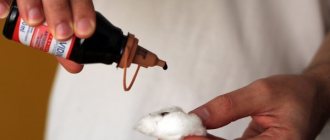Itchy ears in dogs is an extremely unpleasant thing. Owners often call it “ear mange.” The ears may itch deep inside, and no matter what the dog does, the unpleasant sensation does not go away. The dog can scratch its ears with its front and hind paws, rub its head on the carpet, furniture, and people. If you see that your pet is often and intensively trying to “help” you scratch, jerking its back paw when you pat it behind the ear, as if it were scratching itself, welcome to see a veterinarian. If the itching is severe, the dog may scratch his ears until they bleed. It is better not to let this happen and take action at the first signs of illness. It is always easier to prevent a disease than to treat it, and an examination by a doctor is never superfluous.
Diagnostics
Only a veterinarian can make a diagnosis based on anamnesis (collection of information about the pet’s lifestyle), examination and additional research. For example, otoscopy of the middle and inner ear will make it clear where the inflammatory process is localized, and microscopy of the discharge from the auricle will show what exactly could cause the inflammation.
What symptoms may bother your dog besides itching:
- pain - the dog will whine and actively rub its ear with its paws, tilting its head. Trying to look may cause anxiety, discomfort or aggression on the part of the animal;
- a “squelching” sound when pressing on the base of the ear or when the dog shakes its head;
- local redness of the skin, swelling;
- discharge from the ear that is black, gray, yellow or off-white;
- foul odor from the ears;
- enlarged submandibular lymph nodes, general depressed condition of the dog, lethargy;
Each of these symptoms indicates that something is wrong with your ears. The solution to the problem must be approached comprehensively and as quickly as possible.
Itchy ear - what could it be?
What does shaking and scratching indicate?
An experienced owner knows when his dog scratches and shakes his ears, how long this process lasts and what sounds it is accompanied by. Some animals with long ears may make noises such as slaps or pops at this time. But if your pet begins to itch more often than usual, you should take a closer look at the behavior of your four-legged friend, as this may be a symptom of some disease.
The most common cause of shaking ears is the development of an inflammatory process in the ears. It can occur as a result of water, a foreign object entering the ears, due to cold, or infection by a pathogen. Your pet needs emergency medical attention if it exhibits the following symptoms:
- obvious, severe pain;
- there is a visible tumor formation on the ear;
- Pathological discharge that has an unpleasant odor flows from the ear canal.
Even such a common disease as otitis media, if left untreated, can cause your pet to go deaf.
Another common cause of shaking and scratching of the ears is otodectosis or ear scabies, a disease that occurs due to the fact that ear mites grow in the ears. These parasites settle in delicate tissues, causing pain, irritation, and discomfort.
With otodectosis, the dog begins to itch constantly, first imperceptibly injuring the ears, and later tearing them to the point of bleeding. An infection penetrates into the wounds, causing the development of a concomitant illness - otitis media. The presence of red-brownish discharge with a putrid odor from one or both ears is most often a sign of a yeast or fungal infection.
Otohematoma
Otohematoma is an accumulation of blood between the ear cartilage and the skin. It rarely causes itching, but it causes obvious discomfort to the four-legged friend - the dog whines and shakes its head. You will not confuse this disease with anything - the dog’s ear looks like an inflated hot balloon. The cause is damage to a blood or lymphatic vessel (capillary) due to injury. Dogs with floppy ears are predisposed to the appearance of otohematoma, but straight-eared breeds can also suffer. Often, an ear hematoma can occur due to itching, when the dog often scratches its ears, hitting the ear with its paw.
Treatment of otohematoma is usually surgical - drainage is installed at the site of the hematoma, and the skin is sutured to the cartilage.
Prevention of ear diseases in dogs
The occurrence of this problem in pets can be avoided. To do this, it is enough to follow these rules:
- Clean your pet's ears regularly and treat them with a special lotion.
- Make sure that the animal does not roll in the mud. Avoid fighting with other pets.
- Always carefully examine the animal after a walk. Make sure that your Yorkie or a representative of any other breed does not have street dirt, branches, leaves, or hairballs left in their ears. All this can trigger the development of inflammation.
- Get regular checkups with your veterinarian. Perform deworming in a timely manner. Come for unscheduled consultations if you notice an unpleasant odor from your dog’s ears.
- Provide your pet with a balanced diet. His food must contain a lot of vitamins and beneficial microelements.
- Carefully wash your dog's ears, making sure that no water gets into them. If an animal has long hair growing on its head, it needs to be cut off near the ear canals. You can carefully cut it yourself or entrust this task to a veterinarian.
The presented recommendations should be followed by the owner of animals of any breed. However, they are especially important for those caring for a dog with floppy ears. They need to take their pets to the vet regularly to avoid any problems.
Inflammatory otitis media
Otitis media is an acute or chronic inflammatory process in the ear canal. Otitis media can be caused by the development of bacteria, fungi, or both. It may be a skin reaction to injury, parasites, or an allergen. Most often accompanied by severe swelling, inflammation, pain, itching and discharge from the ear with an unpleasant odor. Dog breeds with floppy ears are more prone to developing otitis media.
The treatment is comprehensive, using special medications in the form of drops and solutions, antiseptics and anti-inflammatory drugs. Particular attention is paid to finding the main cause that caused such inflammation.
Causes of itchy ears in dogs
Itching in the ears of dogs is caused by a variety of exo- and endogenous factors. Moreover, if the dog shakes its head, constantly scratches its ears, experiences pain and discomfort, it is very important to establish the root cause as soon as possible by providing assistance to the pet.
Causes of itchy ears in dogs:
- acute, chronic ear diseases (otitis);
- inflammatory processes in the ears;
- fungal infections (mycoses);
- foreign objects in the ear canal;
- ear mites (otodectosis, ear scabies);
- parasitic diseases;
- using alcohol solutions to clean ears;
- allergy;
- hormonal imbalances;
- endocrine pathologies;
- skin diseases (dermatitis, dermatoses, eczema);
- autoimmune diseases, immunological ailments (vasculitis);
- congenital defects and pathologies, genetic, breed predisposition;
- detention in unfavorable conditions, lack of hygiene;
- neoplasms,
- hematomas in the ear canal.
The dog may shake its head and scratch its ears due to water getting into them after bathing. Lack of hygiene, unsystematic or improper care of your pet’s ears can also cause a similar condition in our little brothers.
A dog may shake its head due to injuries received during a walk or due to hypothermia.
Important! Itching and pain in the ears in dogs may indicate the development of hidden viral, bacterial, or parasitic infections.
Often the dog shakes its head and scratches its ears due to the anatomical structure of the ears. Some breeds, due to the shape of their ears, are prone to developing an inflammatory process. For example, in poodles, terriers, Yorkies, dogs with hanging long ears, due to poor ventilation, the ear canal becomes clogged with sulfur secretions, which leads to the development of inflammation.
Breeds that are most susceptible to ear diseases:
- terriers;
- basset hounds;
- dachshund;
- spaniels;
- mastiffs;
- Shar-Pei;
- bloodhound;
- Sheltie;
- collie;
- setters (English, Irish).
Allergic otitis media
Ears are one of the most delicate and vulnerable places. If a dog has inflammation and otitis media of the external auditory canal, then in approximately 70% of cases it will be associated with allergies. The ears become inflamed with food allergies and with atopic dermatitis (allergies to environmental allergens) and allergies to parasites. The outer ear will appear inflamed, and when the owner tries to look inside, the dog may whine, snarl, and try to hide or run away. When examined by a veterinarian through an otoscope, inflammation with discharge (inflammatory secretion) will be detected.
As a rule, treatment for allergic otitis is complex and will be prescribed by a doctor individually for each dog. The treatment regimen may greatly depend on the cause of the allergy. In addition to complex treatment aimed at eliminating the cause of the allergy and relieving symptoms, sanitation and treatment of the ear canal with antibacterial and antifungal drugs will also most likely be prescribed. In order to reduce itching during treatment and thereby make the dog’s life easier, the doctor may prescribe Apoquel. This drug will relieve attacks of itching and eliminate the factor of trauma when scratching; it also helps relieve inflammation.
Treatment of otitis media
Treatment of otitis media is always comprehensive and bilateral, even if only one ear hurts. It consists of systematically cleaning the ears with antiseptic agents and eliminating the main cause of the disease. For this purpose, antibacterial, acaricidal, and antimycotic drugs are prescribed. In veterinary medicine, combination drugs are often used (Amitrazine, Otibiovin, Surolan, etc.)
Considering that otitis usually occurs in weakened dogs, immunomodulators, immunostimulants, and vitamin therapy may be prescribed.
If an allergy is suspected, the treatment regimen also includes antihistamines. It is equally important to identify and eliminate the allergen.
To treat traumatic, chronic purulent otitis media and tumors, surgical intervention may be required.
Foreign body
A dog is not a child and cannot put a foreign object in its ear. But it is not uncommon for grass or tenacious plant seeds, burdock or an insect to accidentally get into the ear. The foreign body causes discomfort to the dog - the dog persistently rubs its ear with its paws and whines. It is necessary to examine the ear yourself as quickly as possible or take your pet to a veterinarian. If a foreign body remains in the ear for a long time, serious inflammation may develop, which will require long-term treatment.
Possible reasons
Why do dogs have itchy ears is a question that worries many owners. This trouble can arise for many reasons, the main ones being disorders in the immune system, the development of pathogenic bacterial microflora, or as a result of ingestion of a foreign object.
Foreign body
Why does a dog eat its own feces: what to do and how to wean it off
After another walk, you can notice that the pet carefully scratches its ears and at the same time makes plaintive moans, trying to extract something from the organ. The foreign object may be a sprig of grass, some stray plant seeds, or a trapped bug.
Important! If you do not seek help from a specialist in time, a foreign body can cause injury to the ear canal, thereby causing serious complications.
Coronavirus enteritis in dogs
The incubation period of this disease is 5 days. It can occur in both acute and mild forms. In acute cases:
- severe ear scratching;
- vomiting and diarrhea;
- complete refusal to eat;
- weakness and lethargy of the animal.
Weakened puppies with coronavirus enteritis may die, but adult puppies are recovering well.
During a mild form of the disease, practically no negative symptoms are observed; only a lack of appetite and complete apathy may occur.
Symptoms of coronavirus enteritis
Otitis media is a common cause of ear scratching.
An inflammatory disease acquired during severe hypothermia or weakening of the body's protective functions. The main symptom is itching of the ear canal, which makes the puppy sick and uncomfortable. The pet may begin to smell strongly and unpleasantly, and a specific discharge may appear.
Note! Other common signs of otitis include increased body temperature, decreased appetite, and apathy.
Allergy
This reaction can occur while taking medications or to foods or plants. The eyes begin to turn red and the ears itch behind them, causing the dog to scratch them until blood appears. But the main signs of an allergic reaction are swelling in the ear area and the presence of hyperemia.
Deafness
If a dog scratches its ear, it may also be due to the presence of wax plugs. If you do not properly care for your pet, their appearance cannot be avoided. As a result, the ear canal becomes blocked and the dog can no longer hear.
Important! After the necessary treatments, hearing will be restored.
Deafness can also occur as a side effect of taking a medication, such as antibiotics. Another common cause of deafness is age-related changes in the hearing aid. There is no cure for this, and over time the dog gets used to his condition and adapts well.
Hematoma
It can occur after a severe injury, abrasion, bite from another dog, tissue rupture, or a foreign body entering the ear. The presence of a hematoma can be determined for the following reasons:
- swelling of the damaged ear;
- soreness;
- constant itching or tilting the head towards the sore spot;
- increase in body temperature.
Important! To prevent your dog from further injuring his ear while scratching his ear, you should immediately seek help from a veterinarian.
Otodectosis
This is a parasitic disease caused by ticks of the genus Otodectes cynotis. The mite feeds on earwax, lymph and epidermis. The vital activity of the parasite causes unbearable itching and inflammation in dogs. Only a veterinarian can confirm the diagnosis of otodectosis after examination and laboratory diagnosis of the discharge - the mite can be easily seen through a microscope.
Dogs suffer from otodectosis much less frequently than cats. But a dog can easily pick up this parasite on the street or from a sick feline.
Treatment for otodectosis is quite simple - hygienic cleaning of the ears and a drug aimed at destroying the Otodectes cynotis mite. Simparica tablets are excellent for treatment and prevention. They do not have a toxic effect on the dog’s body, but are highly active against mites that cause otodecosis.
In addition to tablets, ear mites respond well to treatment with Stronghold drops. For complete recovery, one or two treatments with an interval of 30 days are enough. In the future, the drug can also be used for prevention.
Other parasites
In addition to ear mites, other parasites also attack dog ears - fleas, subcutaneous mites (demodex), scabies mites (sarcoptic mange), and ixodid (forest) mites. Bloodsuckers can be located anywhere on a dog’s body; they also love the ears, because the skin on them is tender enough to easily bite through it. The bites also cause itching. And when a dog itches, it can injure its ear. Trauma can cause both local inflammation and otohematoma. In addition to causing discomfort, fleas and ticks are carriers of dangerous diseases. Therefore, it is much easier to prevent all parasitic diseases than to treat their consequences.
The optimal solution for prevention is Simparica tablets. They protect against fleas and several types of ticks at once - ixodid (forest), ear (otodectosis), scabies (sarcoptic mange), subcutaneous (demodectic mange). In the warm season, the tablet is a dog’s salvation from many parasites and the diseases they carry.
Treatment
Treatment of the ears should be aimed at the cause of inflammation and itching. It is important to maintain hygiene and not allow your dog to itch. To prevent scratching, you can use a collar, but the best solution is Apoquel. This is an innovative drug for relieving itching during diagnosis and treatment. It solves the problem at the cellular level and is well tolerated by the four-legged friend.
For each case there is an individual treatment that must be prescribed by a veterinarian. In order for the doctor to see the clinical picture as much as possible, do not treat the dog’s ears with anything before the doctor’s appointment.
Prevention
The best way to combat a disease is its prevention. To prevent your dog from getting otitis due to parasitic diseases, treat your pet regularly for fleas and ticks. Drugs such as Simparica and Stronghold are active against these parasites and will protect your pets from uninvited guests.
Keep an eye on your pet's ears by cleaning them regularly with lotion and a cotton pad. Do not clean your ear with cotton swabs - this can cause harm. To clean your dog's ears, pour a small amount of lotion into the ear canal, massage the base of the ear and allow the dog to shake its head vigorously. Excess wax will end up on the inside of the ear, where it can be easily wiped off with a cotton pad or gauze.
If you know that your dog is prone to food allergies, carefully follow the diet and talk with all family members so that they do not feed it from the table. This is extremely important for allergic animals. For other types of allergies, when the first signs of exacerbation appear, contact your veterinarian as soon as possible to prevent scratching.
Health to you and your pets!
Precautions and prevention measures
Maintaining proper ear hygiene reduces the likelihood of developing ear diseases.
Regular cleaning of the ear canals will help keep the ears in good condition, preventing the proliferation of pathogenic microflora. For the procedure at home, you need sterile cotton wool, hygiene sticks or cosmetic discs.
To care for the ears, preventative agents are used in the form of solutions, lotions or powder. Apply a small amount of cleaning liquid to a cotton swab and gently wipe the inside of the ear with it. The procedure is carried out 1-2 times a week.
Representatives of long-eared breeds require regular brushing of their ear fur, as dirt, plant particles and insects accumulate on it. Long-haired dogs with floppy ears require regular grooming.
Prevention of ear diseases includes:
- regular treatment of wool with preparations against fleas, ticks and other blood-sucking parasites;
- anthelmintic therapy;
- strengthening the immune system;
- prevention of exposure to allergens contained in feed and hygiene products on the body.
After spending time in nature and swimming, you need to examine your ears, assessing the cleanliness of the ear canal and the condition of the skin around it. If the dog is bothered by itching and pain, accompanied by redness, restless behavior and the appearance of pus, the pet is immediately taken to the veterinarian.











